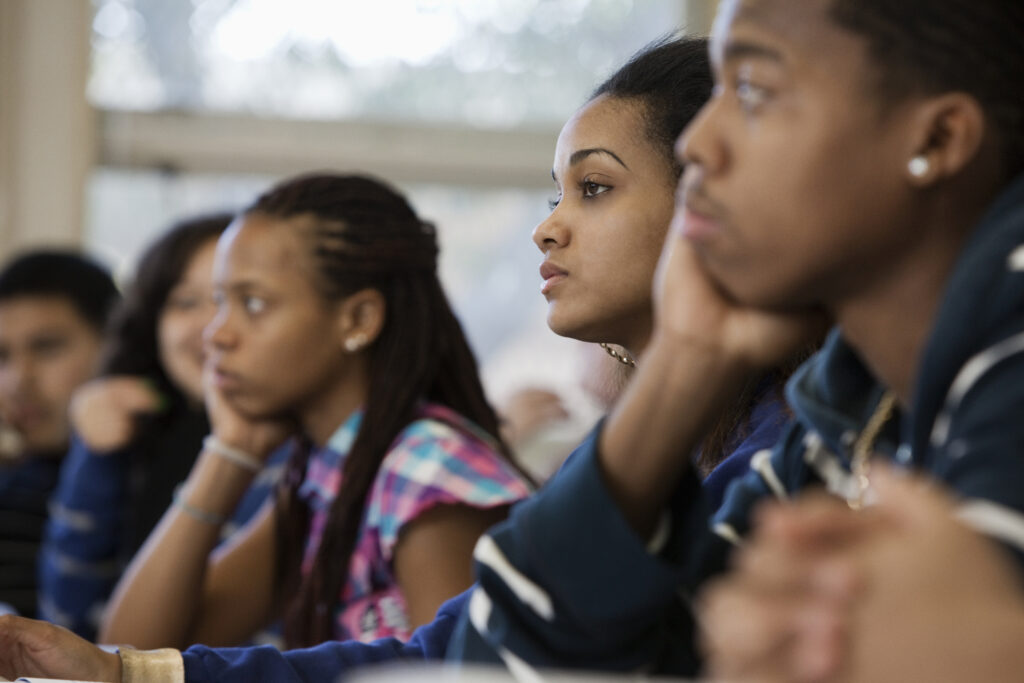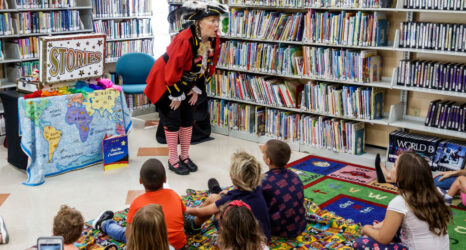
Ms. Classroom wants to hear from educators and students being impacted by legislation attacking public education, higher education, gender, race and sexuality studies, activism and social justice in education, and diversity, equity and inclusion programs for our series, ‘Banned! Voices from the Classroom.’ Submit pitches and/or op-eds and reflections (between 500-800 words) to Ms. contributing editor Aviva Dove-Viebahn at adove-viebahn@msmagazine.com. Posts will be accepted on a rolling basis.
The age that people are coming out as LGBTQIA+ is dropping. This is particularly remarkable for Black youth, many of whom may have previously waited to reveal their sexuality until high school, college or when they move out of their parent’s home. It’s encouraging to see more young people comfortably revealing their full selves, along with parents showing up in solidarity for their children.
But even though awareness and acceptance of Black LGBTQIA+ youth is growing, there is still a lot of work to be done when it comes to equipping them with comprehensive sex education to help them make safe and healthy choices.
Wednesday, Feb. 7, is National Black HIV/AIDS Awareness Day—a day to not only end stigma, but to raise awareness of how HIV disproportionately affects Black people. Across the country, activists will be mobilizing communities to get educated, tested, treated and involved with local HIV/AIDS efforts. While it’s important for us all to unite, I want to make sure we are not forgetting Black lesbian, gay, bisexual, transgender, queer, intersex and asexual (LGBTQIA+) youth—particularly Black adolescent girls, young women and gender-expansive individuals.
Schools should be places where all kids—especially LGBTQIA+ kids, who may not have access to information elsewhere—can reliably learn medically accurate sexual health information so they can have agency over their bodies and protect themselves from life-threatening diseases.
Sex education needs to address more than heterosexual sex. Yet, many state and county agencies are denying tens of thousands of dollars in federal sex ed grants meant to help lower rates of sexually transmitted infections and monitor teens’ sexual behaviors that contribute to high risk through state-wide youth risk behavior surveys (YRBS).
These GOP-led attempts are part of a national push to fortify “parents’ rights” and wipe away LGBTQIA+ content from the classroom.
U.S. Sex Education
Be it illegal, discriminatory or overlooked, LGBTQIA+ inclusive sex education is simply not available for most Black youth.
- Only 38 states and the District of Columbia mandate sex education, and only 18 require sex education instruction be medically accurate.
- Of those, only 10 mandate HIV education and 10 require teachers to provide instruction that is culturally appropriate and that is not biased against any race, sex or ethnicity.
- Only 10 states and D.C. currently offer LGBTQIA+ inclusive sex education.
- Florida, Iowa, Louisiana and Mississippi require only negative information be taught about homosexuality.
- Iowa prohibits instruction on sexually transmitted infections, gender identity or sexual orientation before seventh grade.
- Oklahoma schools are not required to teach sex education; however, they are required to provide HIV/AIDS prevention instruction that is factually incorrect and stigmatizing to same-sex relationships—including curriculum that teaches that “homosexual activity” is “responsible for contact with the AIDS virus.”
School groups and clubs may fill in some of the gaps, but are not a foolproof solution.
At a public elementary school in D.C., a Kaleidoscope Kids club exists to support and advocate for LGBTQIA+ students. But during recent “comprehensive” sex education classes offered to a fifth grade class, one student shared with me that LGBTQIA+ relationships and sex were never mentioned. In spite of this, it was this safe and affirming community nurtured through the school’s club that gave two students the courage to tell their classmates they were gay.
“Remember how Ms. S said we shouldn’t be scared to tell people we are gay,” they said one of the classmates asked during recess in the middle of a game of pickle. “I have to tell you something. … I am gay.”
As a sexuality educator and expert, I worry that our nation’s schools are failing Black LGBTQIA+ girls, young women and gender expansive individuals by not requiring teachers to create safe spaces for non-judgmental instruction and to educate them about how to reduce risks specific to their sexuality.
The Risks of Non-LGBTQIA+ Inclusive Education
Why should this matter? Having a sexuality or gender identity other than your own foisted upon you can be destructive to one’s sense of self. For Black adolescents navigating feelings of romantic or sexual attraction different from their peers, it can feel particularly alienating, placing them at greater risk for depression and suicide.
In 2021, 22 percent of LGBQ+ youth attempted suicide, compared to 6 percent of heterosexual youth. Stigma and weakened support systems LGBTQIA+ adolescents may experience in their schools, homes or communities also increase risks of alcohol and drug abuse.

The stakes are too high to keep denying LGBTQIA+ youth the information and tools they need to stay healthy. Despite the higher risk, only 7 percent of LGBQ+ students have ever been tested for HIV, and the Centers for Disease Control and Prevention’s YRBS recently found only 42 percent of LGB students used a condom the last time they had sex compared to 55 percent of heterosexual students. LGBTQIA+ youth also face higher rates of relationship violence. Twenty percent of LGBQ+ students have been physically forced to have sex when they did not want to compared to five percent of straight students.
While some argue youth aren’t ready for sex or relationships, age-appropriate and inclusive sex education curriculum that teaches students of all identities how to prevent HIV and other sexually transmitted infections as well as how to recognize and respond to intimate partner violence could make a substantial difference in their lives. Making them aware of medical and mental health providers in their community who have experience working with LGBTQIA+ youth could also go a long way in helping them access services when they most need them.
Advocating to Improve Sex Education Standards
Federal, state and local policymakers must continue their efforts to ensure sex education standards include LGBTQIA+ related content so that young people of all sexualities and gender identities can make informed, responsible and healthy choices.
In Our Own Voice’s 2023 Black Reproductive Justice Policy Agenda advocates for legislation like the Real Education for Healthy Youth Act (REHYA) which requires inclusiveness of LGBTQIA+ youth in funded sex education programs and prohibits federal funding of any programs that withhold information about HIV or are unresponsive to the needs of LGBTQIA+ youth.
Even funding evidence-based and youth-friendly LGBTQ programs delivered in community settings can have a positive impact on health. This is particularly important in a time when reproductive and sexual health rights are under attack and may only increase barriers already experienced by LGBTQIA+ youth.
Teachers should also work to incorporate best practices for LGBTQIA+ inclusion in their sex education classes. To help with this, Advocates for Youth has created Rights, Respect, Responsibility: A K-12 Sexuality Education Curriculum. Additionally, the Gay, Lesbian & Straight Education Network has developed an LGBTQ-Inclusive Curriculum Guide for Educators which offers lesson plans and curriculum that fully meet the National Sexuality Education Standards.
Comprehensive sexual health education is a catalyst to the information and empowerment Black LGBTQIA+ adolescent girls, young women and gender expansive individuals need so when they are ready, they can engage in safe and consensual sexual activity. But if they are not, we should at the very least provide them with unrestricted, non-stigmatizing information as they begin to learn about and express their sexuality.
Up next:
U.S. democracy is at a dangerous inflection point—from the demise of abortion rights, to a lack of pay equity and parental leave, to skyrocketing maternal mortality, and attacks on trans health. Left unchecked, these crises will lead to wider gaps in political participation and representation. For 50 years, Ms. has been forging feminist journalism—reporting, rebelling and truth-telling from the front-lines, championing the Equal Rights Amendment, and centering the stories of those most impacted. With all that’s at stake for equality, we are redoubling our commitment for the next 50 years. In turn, we need your help, Support Ms. today with a donation—any amount that is meaningful to you. For as little as $5 each month, you’ll receive the print magazine along with our e-newsletters, action alerts, and invitations to Ms. Studios events and podcasts. We are grateful for your loyalty and ferocity.





